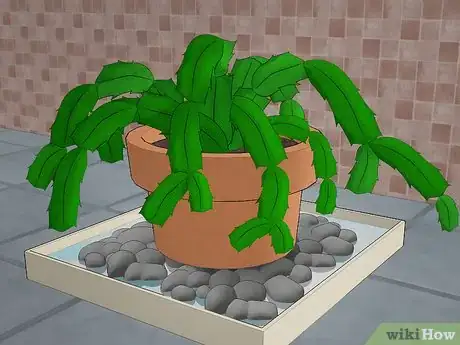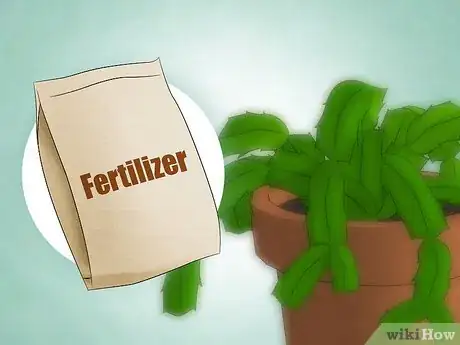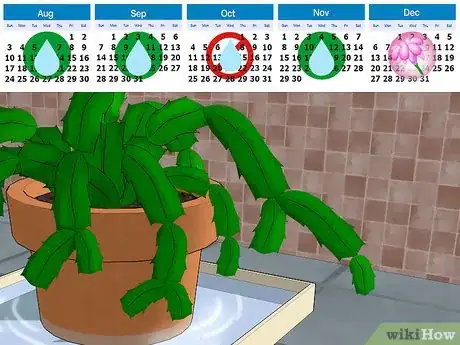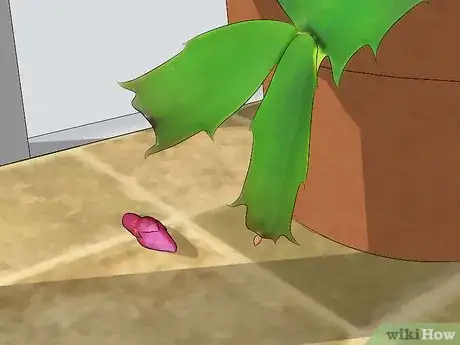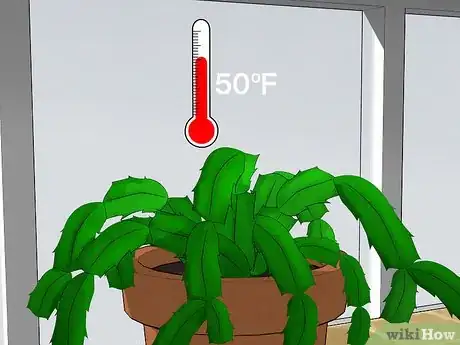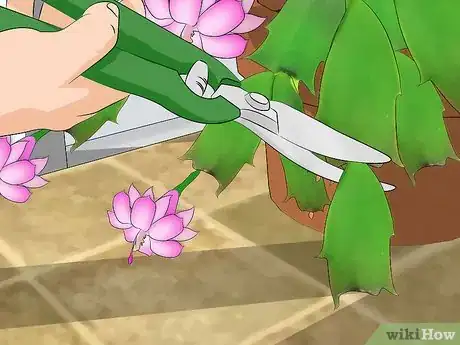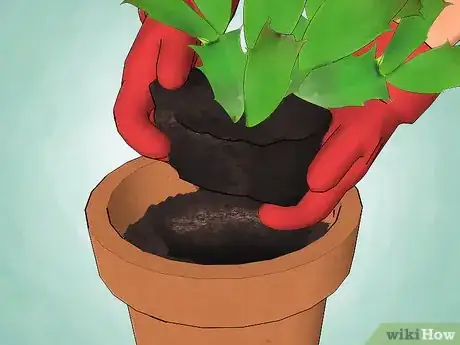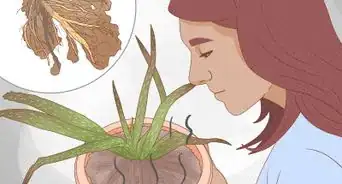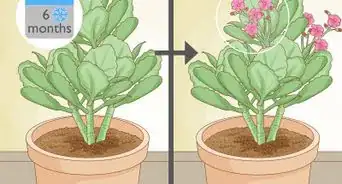This article was co-authored by Harmony Corelitz. Harmony Corelitz is a Plant Specialist and the Ecommerce Manager at Crimson Horticultural Rarities, Inc, a boutiue offering rare plants, flower arragements, and handmade goods. Harmony grew up helping her parents run their family business in plant maintenance and interior plantscaping. Harmony specializes in indoor plant care and interior plant design. Prior to her workwith Crimson Horticultural Rarities, she started her pop-up plant and vintage home goods shop called Younger Child and helped her former employer, Plants and Friends, grow and expand to two locations. She holds a BA from the University of San Francisco.
There are 10 references cited in this article, which can be found at the bottom of the page.
wikiHow marks an article as reader-approved once it receives enough positive feedback. This article received 226 testimonials and 95% of readers who voted found it helpful, earning it our reader-approved status.
This article has been viewed 5,122,381 times.
Wondering how to care for a Christmas cactus? This beautiful holiday plant unsurprisingly blooms at Christmas and sometimes around Easter if cared for properly. A month prior to Christmas you’ll be able to watch the tips of the leaves beginning to grow. The tips grow darker as each day passes until a bud forms. At Christmas time, as if by magic, the buds open to a beautiful flower that will add color and warmth to any holiday season. We'll walk you through all the steps to caring for this seasonal plant–from watering to making your Christmas cactus bloom.
Steps
Caring for a Christmas Cactus
-
1Give your Christmas cactus bright but indirect light.[1] Keep the plant in a well-lit location (like near a window) away from direct sunlight–too much heat and light can stunt growth and burn the leaves.[2] Keep your Christmas cactus away from drafts, heat vents, fireplaces or other sources of hot air.
- Move an indoor plant outdoors in summer to a shady location. It is best to keep your cactus in a normal house temperature range, about 65 to 75°F (18 to 20°C). That being said, cooler night temperatures can be used to initiate blooming. We'll discuss getting it to bloom in a later section.
- If your cactus is in a north or east-facing window, you won't have to worry about light. But if it's in a south or west-facing window, diffuse the light with semi-transparent curtains.
-
2Provide a source of humidity if you live in a dry environment. After all, these are tropical cacti. Put a tray of water next to the plant so that the water evaporates and provides humidity. Alternatively, you can make a humidity tray by placing the pot on a waterproof saucer that is filled with gravel and halfway filled with water.[3]
- Make sure to not let the pot touch the water when it is sitting on the gravel; otherwise the pot will pick up water and make it easier for the roots to rot.
- You can also mist your plant 2-3 times a week to give it a humidity boost.
- 50 to 60% humidity is the ultimate goal. If your environment is close to that, you should be fine.
Advertisement -
3Use a well-draining container and well-draining soil. Cheap nursery planters will work well as containers, and orchid planters (the plastic basket kind) are fine, too. Pair this planter with a planter that will hold water and allow the basket to fit down into it.[4] Then, place a few medium-sized rocks into the bottom so that the basket container will sit about an inch above the bottom.
- Use a combination of 3 parts potting soil to 1 part sand for the potting medium. An alternative is 1 part potting soil, 2 parts peat moss or compost, and 1 part sharp sand or perlite.
- Pour about 2 inches (5.1 cm) of room temperature water into the outer container and set the basket container inside. After about 12 hours, pour out any remaining water. Repeat this as often as the plant needs water, which will vary based on your home environment. Monitor your cactus with a moisture prod and adjust accordingly.
-
4Add fertilizer to assist plant growth. Give your actively growing plant a blooming houseplant-type fertilizer. This is best done for a plant that is 2-3 weeks old. Follow the label directions for how much and how often to feed. However, you should be able to get away with using half the recommended amount of liquid fertilizer.[5]
- Fertilizing is important to keep the plant in good condition; the joints are fragile and can break apart if the plant descends into poor health. Generally, it should be fertilized 2-4 times a year with a 20-20-20 feed, but stop feeding about a month before the buds appear (this usually means stopping by the end of October).
Watering Your Christmas Cactus
-
1Water a Christmas cactus with care. Caring for this plant can be a bit tricky as you need to take care not to overwater or underwater it. A Christmas cactus is a tropical cactus, not a desert cactus. Unlike most desert cacti, this variety cannot tolerate completely dry soil. If the soil gets too dry, the flowers buds will drop, and the plant will wilt. Water when the top 1 inch (2.5 cm) of soil feels dry.[6]
- Once you water the plant, let it dry about three-quarters of the way before you water it again.[7]
- Too much watering will cause spots from white rot to appear on the leaves, and the leaves will likely fall off. The soil should be evenly moist for best growth. The rule of thumb is less water is better than too much water.
- When watering, thoroughly water the plant. Before attempting to water the plant again, check to see that the top inch of soil has dried thoroughly first. Mist leaves as well as watering the soil.
-
2Change your watering schedule seasonally. Water the cactus based on your environment and the time of year.[8] A good method is to water a cactus as follows:
- Dry climate, outdoors: Water every 2-3 days when warm and sunny
- Humid, cool or indoors: Water every week
- During the fall and winter months, the plants should be watered less frequently in order to promote blooming.
-
3Stop watering around October. When October hits, your watering duties are over. You can carefully resume a light watering in November. If it's dry where you live, feel free to place the pot over a tray of moist pebbles. This watering schedule will prep your plant to bloom around Christmas.[9]
- The only other time you should stop watering is after the plant blooms. At this time, cease watering for about 6 weeks to let the plant rest. New growth will still appear–and that’s when you can start watering again.
-
4Watch out for bud drop. One of the most frustrating things that can happen to Christmas cactus is after the flower buds have developed, they drop off the plant. Bud drop can be caused by several different conditions. Usually it's because of over-watering, but it can also be due to a lack of humidity or insufficient light.[10]
- If this starts happening, water the plant less and add some fertilizer to the pot. Move it to an area away from a hot radiator or vent and try a new spot where it can get a bit more sunlight.
Getting a Timely Bloom
-
1Encourage the flower blooming for the holiday season by lowering the temperature. The key to getting Christmas cactus to flower during the holiday season is proper light exposure, correct temperatures and limited watering. If you manipulate these things yourself, you can time a bloom just how you'd like.[11]
- Because this plant is thermo-photoperiodic, it will set buds when day length is about equal to night length and when the temperature drops to 50 to 60 degrees F for several weeks. If the temperature drops further, the plant will not bloom.
- If you keep your plant outdoors, bring it inside if the temperature is going to drop below about 50 °F (10 °C).[12]
- From September and October, the Christmas cactus should be kept in a cool room where temperatures will remain around 50-55°F (10-12°C), give or take a few degrees. Don't expose the plant to freezing temperatures. Plants should be blooming for the holidays if cool treatments are started by early November.
-
2Keep the plant in a dark room during the night. During the fall months, the Christmas cactus should be placed in a spot where it receives indirect, bright light during the daylight hours but total darkness at night – it requires long, uninterrupted dark periods of about 12 hours or more.[13]
- Begin the dark treatments in about mid-October to have plants in full bloom by the holidays. Place the plants in a dark area from about 12 or more hours each night for 6-8 weeks or until you see buds forming. A closet or unused bathroom are ideal places.
- Be especially careful with watering at this time. Reduce the watering slightly. Do not soak the soil after a dry period; only moisten the top few inches, since buds, flowers and even leaves can fall off if the roots are suddenly saturated.
- Avoid turning on lights in the dark room, even for brief periods of time.
-
3When you see flower buds forming, increase light and humidity. The "dark ages" are over when your plant starts budding. At this point, increase humidity, light, water (not too much, of course), and the temperature. In other words, continue as you were a few months ago.[14]
- If the buds form too early, you can lower the temperature to stunt them. When you're ready, up the temperature and they should resume their progress.
Caring for Your Cactus Post-Bloom
-
1Prune the Christmas cactus about a month after blooming. This will encourage the plant to branch out, especially after a period of "rest.” It will not look very pretty after the blossoms have faded. Some people wait until March or so, when new growth begins, to prune the cactus.[15]
- Christmas cactuses don’t require a lot of pruning, but you can remove dead material and overgrowth.
- As mentioned before, cease watering for 30 days post-bloom. When you see new growth forming, you can begin watering again.
-
2Propagate a Christmas Cactus by cutting off short, Y-shaped sections of the stem. Each section must consist of 2 or 3 joined segments. Allow each section to dry for a few hours before pushing them into a 3-inch pot that contains the same potting soil as the parent plant.[16] Plant halfway down the first segment and water sparingly to prevent rot from developing.
- Treat the cuttings as mature plants. In about four to six weeks, the cuttings should have rooted and will begin to show some new growth. They grow quickly, and should take in about 2 or 3 weeks. You can fertilize after the cutting has grown one new segment.
-
3Repot every 2-3 years. Your plant should be fine for a couple of years unless the root system gets diseased or harmed. Apart from this, a new pot is needed when the roots have filled it or when the soil has been officially depleted of nutrients. Most people do this in the spring.[17]
- When replanting or repotting, use new, fresh soil. It's worth the few extra dollars since it will probably be sitting in that soil for a long time. Your plant is a living thing like you, so it deserves the best.
- The best time for repotting is between February and April, about once every three years. Just be sure not to give it a pot that's too big–the Christmas cactus flowers best when it's pot-bound.
Expert Q&A
Did you know you can get expert answers for this article?
Unlock expert answers by supporting wikiHow
-
QuestionDo Christmas cactus need full sun?
 Maggie MoranMaggie Moran is a Professional Gardener in Pennsylvania.
Maggie MoranMaggie Moran is a Professional Gardener in Pennsylvania.
Home & Garden Specialist
-
QuestionHow many times a year does a Christmas cactus bloom?
 Maggie MoranMaggie Moran is a Professional Gardener in Pennsylvania.
Maggie MoranMaggie Moran is a Professional Gardener in Pennsylvania.
Home & Garden Specialist
-
QuestionHow often do you need to water a Christmas cactus?
 Maggie MoranMaggie Moran is a Professional Gardener in Pennsylvania.
Maggie MoranMaggie Moran is a Professional Gardener in Pennsylvania.
Home & Garden Specialist
Warnings
- Any sudden changes in temperature, light, and watering will damage the Christmas cactus. Drafts and temperature extremes can cause the flower buds to drop from the plant before they have a chance to open. Introduce changes gradually.⧼thumbs_response⧽
- ASPCA animal poison control center shows Christmas cacti as non-toxic to dogs and cats.[18]⧼thumbs_response⧽
References
- ↑ https://www.extension.iastate.edu/linn/news/it-thanksgiving-christmas-or-easter-cactus
- ↑ Harmony Corelitz. Plant Specialist. Expert Interview. 4 December 2020.
- ↑ https://www.gardenersworld.com/how-to/grow-plants/how-to-grow-christmas-cactus/
- ↑ https://agrilife.org/etg/2012/12/26/christmas-cactus-care/
- ↑ https://pitt.ces.ncsu.edu/2015/12/christmas-cactus-care/
- ↑ https://www.extension.iastate.edu/linn/news/it-thanksgiving-christmas-or-easter-cactus
- ↑ Harmony Corelitz. Plant Specialist. Expert Interview. 4 December 2020.
- ↑ https://pitt.ces.ncsu.edu/2015/12/christmas-cactus-care/
- ↑ https://pitt.ces.ncsu.edu/2015/12/christmas-cactus-care/
- ↑ https://hgic.clemson.edu/factsheet/thanksgiving-christmas-cacti/
- ↑ https://hgic.clemson.edu/factsheet/thanksgiving-christmas-cacti/
- ↑ Harmony Corelitz. Plant Specialist. Expert Interview. 4 December 2020.
- ↑ https://www.canr.msu.edu/news/the_secret_to_getting_a_christmas_cactus_to_bloom_temperature_and_light
- ↑ https://extension.psu.edu/poinsettia-and-christmas-cactus-care
- ↑ https://www.rhs.org.uk/advice/profile?PID=840
- ↑ https://agrilife.org/etg/2012/12/26/christmas-cactus-care/
- ↑ Harmony Corelitz. Plant Specialist. Expert Interview. 4 December 2020.
- ↑ https://www.aspca.org/pet-care/animal-poison-control/toxic-and-non-toxic-plants/christmas-cactus
About This Article
Plant your Christmas Cactus in a well-draining nursery planter and fill it with potting soil and sand in a 3:1 ratio. Place a tray of water next to it to create humidity. Set the cactus in bright but indirect light, such as near a window, moving it to a shady spot outside for the summer. Water the dirt and leaves whenever the top inch of soil gets dry, and stop watering in October to get ready for the bloom. Lower the temperature to 50 to 55 °F until the buds form, then increase light, temperature, and humidity for the rest of the bloom. For tips on how to make sure your Christmas cactus blooms in time for Christmas, read on!


